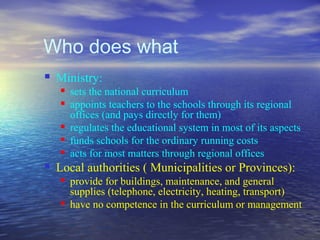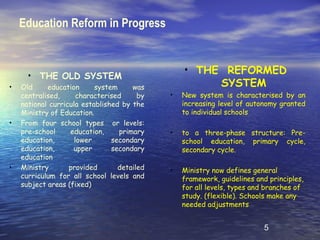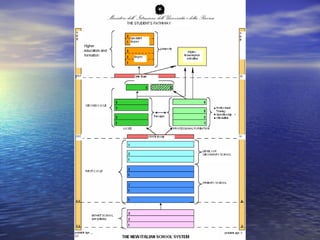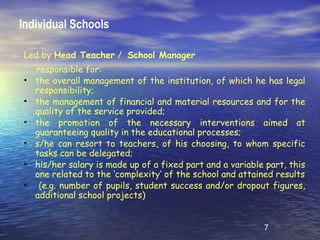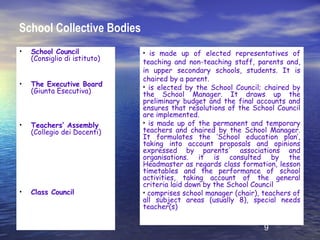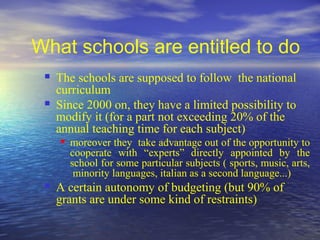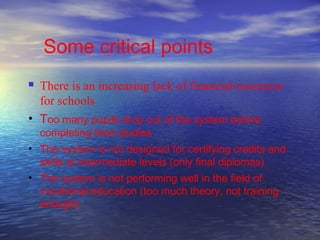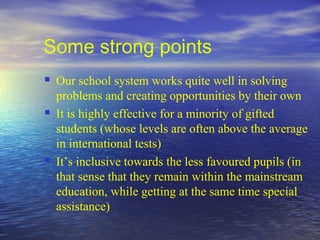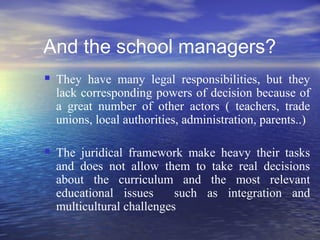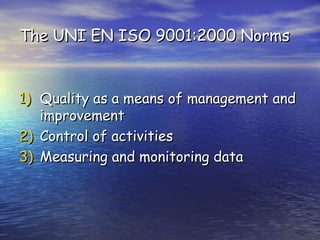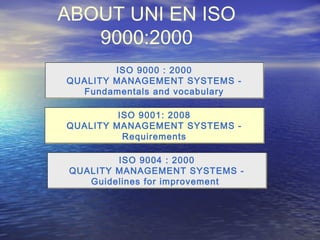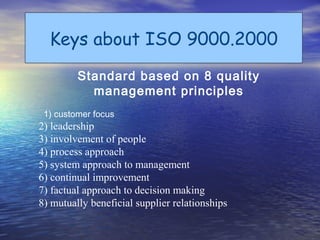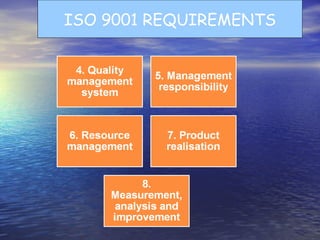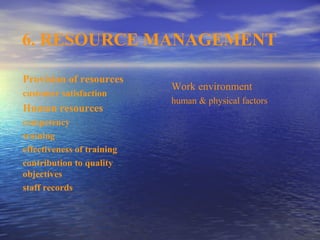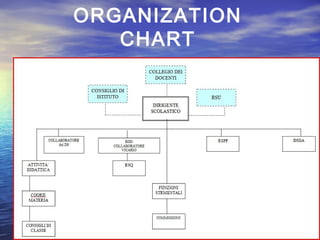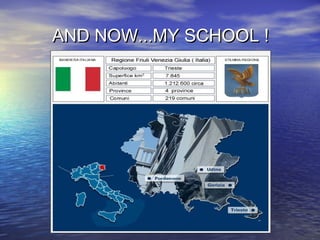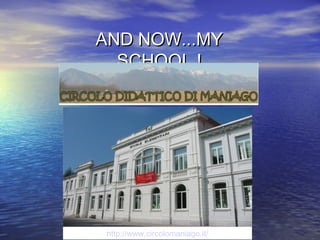Italian School Management
- 1. HOW DO WE MANAGE OUR SCHOOLS ? Mara Bonitta Circolo Didattico Maniago ( PN) ITALY
- 2. MIUR:Ministry of Education, University and Research ŌĆó Central authority, responsible for supervising and coordinating scholastic institutions throughout the country. The Ministry of Education, University and Research lays down : ŌĆó╠²the general goals and learning outcomes of the school process; ŌĆó specific learning objectives related to student competence levels; ŌĆó the subjects and activities which make up the national curriculum quota and annual teaching hours for these; ŌĆó general indications for student evaluation and assessment. 2
- 3. 21 Regional Education Offices ŌĆó At peripheral level, the U.S.R. or Regional Education Offices were instituted in the late ŌĆÖ90s; ŌĆó Led by General Manager for Education; ŌĆó Appointed by the MIUR; ŌĆó Duration of appointment varies. Regional Education Authorities: ŌĆó are autonomous centres with administrative responsibility; ŌĆó have residual state functions which have been transferred neither to the Regions nor to the schools (for example: the determination of the number of the schoolsŌĆÖ staff ŌĆó have functions related to the relationships with the Regions, local authorities, universities and formative agencies; ŌĆó are present also at provincial level through the centres for administrative support to schools, called Provincial Education Office. 3
- 4. Who does what ’ü« Ministry: ’ü« sets the national curriculum ’ü« appoints teachers to the schools through its regional offices (and pays directly for them) ’ü« regulates the educational system in most of its aspects ’ü« funds schools for the ordinary running costs ’ü« acts for most matters through regional offices ’ü« Local authorities ( Municipalities or Provinces): ’ü« provide for buildings, maintenance, and general supplies (telephone, electricity, heating, transport) ’ü« have no competence in the curriculum or management
- 5. Education Reform in Progress ŌĆó THE REFORMED ŌĆó THE OLD SYSTEM ŌĆó Old education system was SYSTEM centralised, characterised by ŌĆó New system is characterised by an national curricula established by the increasing level of autonomy granted Ministry of Education. to individual schools ŌĆó From four school types or levels: pre-school education, primary ŌĆó to a three-phase structure: Pre- education, lower secondary school education, primary cycle, education, upper secondary secondary cycle. education ŌĆó Ministry provided detailed ŌĆó Ministry now defines general curriculum for all school levels and framework, guidelines and principles, subject areas (fixed) for all levels, types and branches of study. (flexible). Schools make any needed adjustments 5
- 7. Individual Schools Led by Head Teacher / School Manager responsible for: ŌĆó the overall management of the institution, of which he has legal responsibility; ŌĆó the management of financial and material resources and for the quality of the service provided; ŌĆó the promotion of the necessary interventions aimed at guaranteeing quality in the educational processes; ŌĆó s/he can resort to teachers, of his choosing, to whom specific tasks can be delegated; ŌĆó his/her salary is made up of a fixed part and a variable part, this one related to the ŌĆścomplexityŌĆÖ of the school and attained results ŌĆó (e.g. number of pupils, student success and/or dropout figures, additional school projects) 7
- 8. School Autonomy (all must be worked into a ministerial outline and framework, to ensure uniformity throughout the country ) ŌĆó School autonomy ŌĆó 1997 - Law 59: the old centralised school system was dismantled and School Autonomy granted (teaching, administration, research activities, experimentation and development). ŌĆó Education Offer Plan ŌĆó Schools determine and implement the educational ( P.O.F.) offer: each school prepares the Education Offer Plan yearly. ŌĆó Teaching autonomy ŌĆó Flexibility in organising school time and teaching time in the way which is better suited to the study ŌĆó Organisation autonomy and learning rhythms ŌĆó Overall timetable can be adopted to the Education ŌĆó Autonomy in research, PlanŌĆÖs requirements; experimentation and development ŌĆó Teaching staff and other personnel plan training activities, set up ŌĆśnetwork agreementsŌĆÖ with other schools, education institutions, businesses, etc. 8
- 9. School Collective Bodies ŌĆó School Council ŌĆó is made up of elected representatives of (Consiglio di istituto) teaching and non-teaching staff, parents and, in upper secondary schools, students. It is chaired by a parent. ŌĆó The Executive Board ŌĆó is elected by the School Council; chaired by (Giunta Esecutiva) the School Manager. It draws up the preliminary budget and the final accounts and ensures that resolutions of the School Council are implemented. ŌĆó TeachersŌĆÖ Assembly ŌĆó is made up of the permanent and temporary (Collegio dei Docenti) teachers and chaired by the School Manager. It formulates the ŌĆśSchool education planŌĆÖ, taking into account proposals and opinions expressed by parents' associations and organisations. it is consulted by the Headmaster as regards class formation, lesson timetables and the performance of school activities, taking account of the general criteria laid down by the School Council ŌĆó Class Council ŌĆó comprises school manager (chair), teachers of all subject areas (usually 8), special needs teacher(s) 9
- 10. What schools are entitled to do ’ü« The schools are supposed to follow the national curriculum ’ü« Since 2000 on, they have a limited possibility to modify it (for a part not exceeding 20% of the annual teaching time for each subject) ’ü« moreover they take advantage out of the opportunity to cooperate with ŌĆ£expertsŌĆØ directly appointed by the school for some particular subjects ( sports, music, arts, minority languages, italian as a second language...) ’ü« A certain autonomy of budgeting (but 90% of grants are under some kind of restraints)
- 11. Some critical points ’ü« There is an increasing lack of financial resources for schools ŌĆó Too many pupils drop out of the system before completing their studies ŌĆó The system is not designed for certifying credits and skills at intermediate levels (only final diplomas) ŌĆó The system is not performing well in the field of vocational education (too much theory, not training enough)
- 12. Some strong points ’ü« Our school system works quite well in solving problems and creating opportunities by their own ’ü« It is highly effective for a minority of gifted students (whose levels are often above the average in international tests) ’ü« ItŌĆÖs inclusive towards the less favoured pupils (in that sense that they remain within the mainstream education, while getting at the same time special assistance)
- 13. And the school managers? ’ü« They have many legal responsibilities, but they lack corresponding powers of decision because of a great number of other actors ( teachers, trade unions, local authorities, administration, parents..) ’ü« The juridical framework make heavy their tasks and does not allow them to take real decisions about the curriculum and the most relevant educational issues such as integration and multicultural challenges
- 14. Who assesses the schools ’ü« There is no systematic assessment of schools ’ü« From 2001 up to 2004 there has been a national system of tests for studentsŌĆÖ achievements (only for schools that decided to make use of it) ’ü« many schools actually did (80% approx.) ’ü« only for 2005-2006 this system has been compulsory ’ü« from 2007 on, it will be operated only on a sample of schools (approx. 5%) ’ü« There is no assessment for schools as a whole, nor for individual teachers
- 15. The UNI EN ISO 9001:2000 Norms 1) Quality as a means of management and improvement 2) Control of activities 3) Measuring and monitoring data
- 16. ABOUT UNI EN ISO 9000:2000 ISO 9000 : 2000 QUALITY MANAGEMENT SYSTEMS - Fundamentals and vocabulary ISO 9001: 2008 QUALITY MANAGEMENT SYSTEMS - Requirements ISO 9004 : 2000 QUALITY MANAGEMENT SYSTEMS - Guidelines for improvement
- 17. Keys about ISO 9000.2000 Standard based on 8 quality management principles 1) customer focus 2) leadership 3) involvement of people 4) process approach 5) system approach to management 6) continual improvement 7) factual approach to decision making 8) mutually beneficial supplier relationships
- 19. 4. QUALITY MANAGEMENT SYSTEM General requirements identify QMS processes sequence & interaction of processes criteria & measures for effective operation information to support processes measure, monitor, analyse, action & improvement General documentation requirements procedures other documents
- 20. 5. MANAGEMENT RESPONSIBILITY Management Administration commitment responsibility & authority Customer focus management representative internal communication Quality policy quality manual Planning control of documents quality objectives control of quality records quality planning Management review inputs outputs
- 21. 6. RESOURCE MANAGEMENT Provision of resources Work environment customer satisfaction human & physical factors Human resources competency training effectiveness of training contribution to quality objectives staff records
- 22. 7. PRODUCT REALISATION Planning of realisation Purchasing processes control Customer related processes information Design & development verification planning Production & service operations inputs control outputs identification & traceability review customer property verification preservation validation measuring & monitoring changes
- 23. 8. MEASUREMENT, ANALYSIS & IMPROVEMENT Planning Measurement & monitoring customer satisfaction internal audit processes product control of non comformity analysis of data
- 24. ORGANIZATION CHART
- 25. AND NOW...MY SCHOOL !
- 26. AND NOW...MY SCHOOL ! http://www.circolomaniago.it/
- 27. Warning to navigators ŌĆ£ It is necessary to learn to navigate in an ocean of doubts between archipelagoes of certaintiesŌĆØ ( E. Morin)




